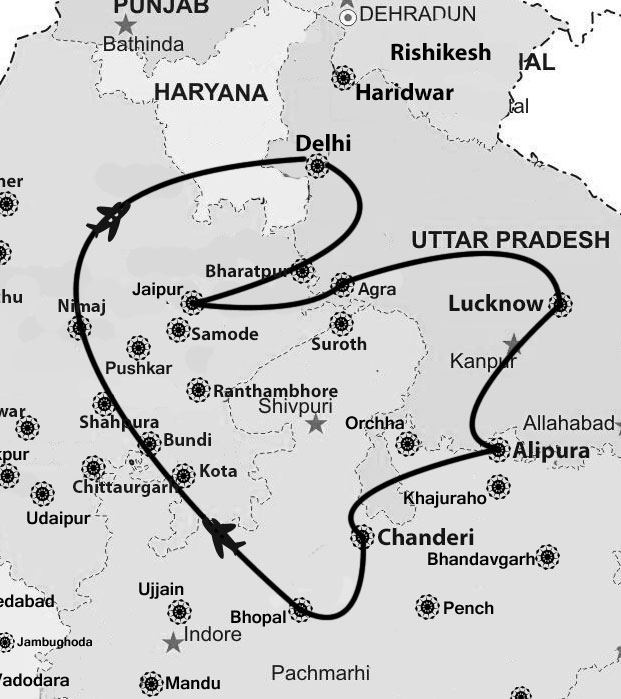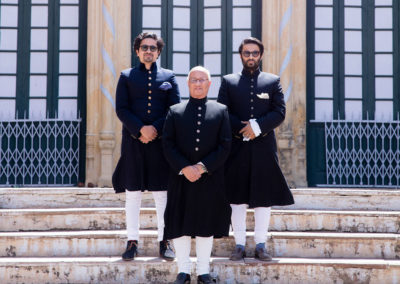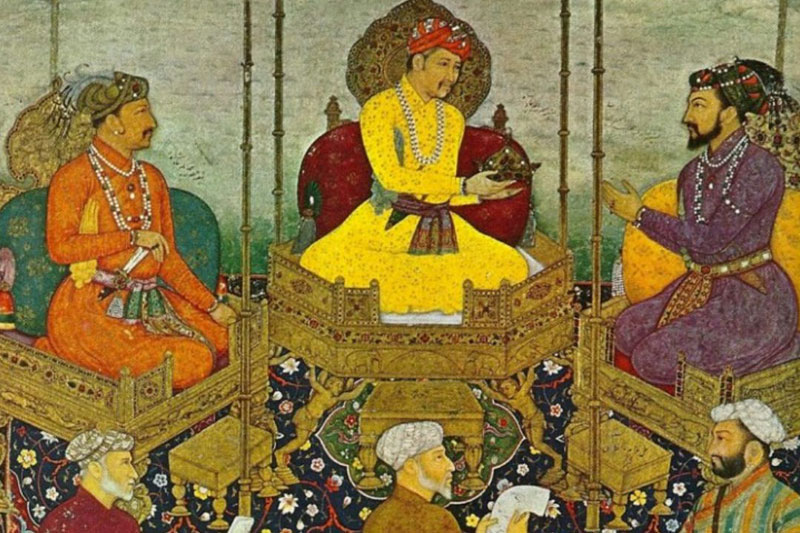Airport welcome and check in at the hotel in the center of Delhi. Night in hotel.
Breakfast at hotel.
Then, go down to Old Delhi to visit the 17th century Jama Masjid, the largest mosque in India. You will be visiting streets of old Delhi on cycle rickshaw, See Chandni Chowk, the shopping center of old Delhi and drive past the Red Fort for a photo stop. Visit Raj Ghat where Mahatma Gandhi was cremated.
Visit of New Delhi is built in a typically British colonial style with tree-lined avenues and colonial bungalows. Drive past the Parliament House, the Secretariat buildings and the Vice Regal Palace, now the official residence of the President of India.
Visit Hazrat Nizamuddin Basti. After the visit to the Basti, you may want to go to the Dargarh and listen to Qawwali, which is a musical prayer sung in a group accompanied by rhythmic claps. This musical tradition stretches back more than 700 years. Often listeners, and even artists themselves, are transported to a trance-like state where they feel at one with the Supreme.
Note: Thursday & Friday evenings are a sure bet for experiencing Qawwali at the Dargah of Hazrat Nizamuddin Auliya. Performance times are 6:00 – 7:30 PM and 9:00 – 10:30 PM.
Breakfast at hotel
Leaving for Jaipur: Jaipur (City of Victory) was founded by Maharaja Sawai Jai Singh II in 1727. It is the only city in the world symbolizing the nine divisions of the Universe through nine rectangular sectors sub-dividing it.
On a fascinating late afternoon walk mingle and talk with the locals while learning about some of the regions culinary delights: pakoras, aloo tiki, samosa and sweets from some of the city’s most popular street food vendors. Observe local artisans in their workshops, jewelers and silversmiths, gold and silver foil makers. You also have the option of seeing and trying the art of Henna painting. This is a 2½ hour walk.
Breakfast at hotel
visit the City Palace that houses a museum containing rare manuscripts, paintings and an armory. Continue to the Royal Observatory (Jantar Mantar) built in the 17th century by Jai Singh, a famous astronomer. The observatory has a 900-foot-high sundial. The Central museum founded in 1876 has a large collection of antiques. Later drive past the Hawa Mahal also known as the “Palace of Winds”. Hawa Mahal built in a unique design is the landmark of Jaipur and was used by the ladies of the court to watch the daily goings on in the street below. The pink sandstone carvings are extremely intricate and we can take you to restaurant situated opposite of it, which is a great place to take pictures.
In the evening, we will invite you to watch “famous Bollywood cinema “ at Raj Mandir cinema: unique experience! Indian cinema, more commonly known as "Bollywood" is a tradition or a way of life in India.
Breakfast at hotel.
Depart by surface to Agra while visiting stepwell of Abhaneri.
Chand Baori at Abhaneri Village in Rajasthan is the most photogenic step well of India. When you stand next to this 13 story deep step well with symmetric triangular steps leading to the water at the bottom, you cannot but be mesmerized. You, of course, understand that in the desert of Rajasthan, it is a practical water management solution. It also serves as a natural cooler in summer months. But, what inspired the people of those days to build it so beautifully.
Post visit driving to Agra.
visit the massive Agra Fort which was originally started by the Emperor Akbar in 1565, but his son, Jahangir, and grandson, Shah Jahan, later made valuable additions to it. It houses the Dewan-e-Khas and Dewan-e-Aam (Halls of Private and Public Audience). Its walls and palaces are a silent witness to the rise and fall of the Imperial Mughal Empire and feature a variety of ingenious Islamic inspired devices (some decorative, some more practical) within the fabric of the buildings. It’s a citadel with marble palaces, ornate alcoves, and terrace pavilions.
Late afternoon enjoy Hi Tea with local family and later proceed for Kachpura Heritage Walk. A narrow bridle path through agriculture fields near Mehtab Bagh takes you into the ancient village of Kachpura and Humayun’s Mosque. The walk ends in Mehtab Bagh from where you will have the opportunity to watch the Taj Mahal during sunset from across the river.
Early morning tea or coffee
Visit the Taj Mahal at sunrise.
The Mughal Emperor Shahjahan built the Taj Mahal in 1630 AD to enshrine the mortal remains of his beloved Queen Mumtaz Mahal. The Taj Mahal manifests the wealth and luxury of Mughal art as seen in architecture and garden design, painting, and calligraphy. The 144-foot double dome of the Taj is capped with a finial and the four minarets are each 131 ft high and crowned by an open octagonal pavilion highlight the perfect symmetry of the tomb.
Return to the hotel for breakfast and depart for Lucknow. After long day driving, evening for relax.
Breakfast at hotel.
Enjoy a tour of Lucknow city – visit the beautiful Bara Imambara built by Asaf-ud-Daula in the year 1784 and the Residency, which played an important role in the history of the region during the rebellion of 1857.
A walk through the streets and galis (laneways) where Lucknow’s famous street food abounds – particularly its well-known barbeque tikka and kebabs. Lunch will be at Tunda’s Kebabs, which is one of the city’s most popular food outlets.
In the evening you’ll be taken to a Nawab’s Haveli (traditional home of a local ruler) where you will be served the famous local cuisine, Awadhi. The recipes of many of the dishes prepared for dinner would have been passed down from the forefathers of the Nawab’s family.
Breakfast at hotel.
Transfer by surface for a ride across rough Indian roads to Alipura. This friendly village will be our base for two days where you'll stay in a heritage property with time to wander the town and interact with local people.
Breakfast at hotel.
Transfer by surface to a small medieval town that’s home to a multicultural mix of Muslims, Hindus and Jains. While it’s off the beaten tourist track, Chanderi is nonetheless full of historic Jain temples and fascinating history. You will visit fabrications and meeting artisans who use to make dresses for Nawabs.
Breakfast at hotel.
Transfer by surface to Bhopal- another land of Nawabs.
Bhopal- Known as city of lakes for it natural and artificial lakes . Split by a pair of lakes, Bhopal is two cities within a city. Two starkly contrasting cityscapes.
Towards the North you have the old city, a fascinating area of mosques, serpentine alleys, chowks, milling crowds, exotic havelis and crowded bazaars.
South of the two lakes is the new Bhopal. Modern, with wide roads, upmarket shopping complexes, and plush hotels and restaurants nestled comfortably in the Arera and Shamla Hills, which overlook the lakes and the old city beyond. The central district is known as New Market. Ruled by the wives (begums) of the nawabs for over a hundred years.
Later evening you can enjoy Heritage walk and dinner with Local Bhopali Family staying in Old Palace.
Breakfast at hotel.
Today you will go for sightseeing tour of Bhopal- another city of Nawabs or you can say of Begums.
You will visit the Jama Masjid, built by Qudsia Begum, has tall dark minarets crowned with glittering golden spikes. The Moti Masjid is patterned on Delhi's Jama Masjid. Among more recent constructions of note are the Tah-ul-Masjid, started by Begum Shah Jahan and completed in 1982. It has an impressive main hall, inter-arched roof, broad facade and wide courtyard with a shopping arcade - Taj market - around its boundary walls. Stopover at Bharat Bhavan, a multi-arts centre without parallel in India, was designed by one of India's leading architects - Charles Correa. It houses a beautiful gallery, fine art workshop, open-air amphitheatre, studio theatre, auditorium, museum of tribal and folk art, and libraries of Indian poetry and folk music. Another outstanding feature of Bhopal is its two picturesque lakes. An over-bridge divides one lake into two - Upper Lake and Lower Lake. A large expanse of water, the Upper Lake is over 2 sq. km in area. From the two high points of Idgah and Shamla, you get a fabulous view of the sunset on the lakes and of the twinkling city lights in the distance.
Breakfast at hotel. Transfer to airport to onboard flight, couple of hours in capital of India before onboard return flight.







